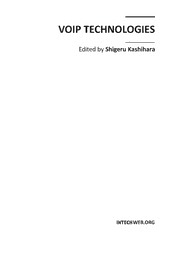
VoIP Technologies PDF
Preview VoIP Technologies
VOIP TECHNOLOGIES Edited by Shigeru Kashihara VoIP Technologies Edited by Shigeru Kashihara Published by InTech Janeza Trdine 9, 51000 Rijeka, Croatia Copyright © 2011 InTech All chapters are Open Access articles distributed under the Creative Commons Non Commercial Share Alike Attribution 3.0 license, which permits to copy, distribute, transmit, and adapt the work in any medium, so long as the original work is properly cited. After this work has been published by InTech, authors have the right to republish it, in whole or part, in any publication of which they are the author, and to make other personal use of the work. Any republication, referencing or personal use of the work must explicitly identify the original source. Statements and opinions expressed in the chapters are these of the individual contributors and not necessarily those of the editors or publisher. No responsibility is accepted for the accuracy of information contained in the published articles. The publisher assumes no responsibility for any damage or injury to persons or property arising out of the use of any materials, instructions, methods or ideas contained in the book. Publishing Process Manager Jelena Marusic Technical Editor Teodora Smiljanic Cover Designer Martina Sirotic Image Copyright WitR, 2010. Used under license from Shutterstock.com First published February, 2011 Printed in India A free online edition of this book is available at www.intechopen.com Additional hard copies can be obtained from [email protected] VoIP Technologies, Edited by Shigeru Kashihara p. cm. ISBN 978-953-307-549-5 free online editions of InTech Books and Journals can be found at www.intechopen.com Contents Preface IX Chapter 1 VoIP Quality Assessment Technologies 1 Mousa AL-Akhras and Iman AL Momani Chapter 2 Assessment of Speech Quality in VoIP 27 Zdenek Becvar, Lukas Novak and Michal Vondra Chapter 3 Enhanced VoIP by Signal Reconstruction and Voice Quality Assessment 45 Filipe Neves, Salviano Soares, Pedro Assunção and Filipe Tavares Chapter 4 An Introduction to VoIP: End-to-End Elements and QoS Parameters 79 H. Toral-Cruz, J. Argaez-Xool, L. Estrada-Vargas and D. Torres-Roman Chapter 5 Influences of Classical and Hybrid Queuing Mechanisms on VoIP’s QoS Properties 95 Sasa Klampfer, Amor Chowdhury, Joze Mohorko and Zarko Cucej Chapter 6 VoIP System for Enterprise Network 127 Moo Wan Kim and Fumikazu Iseki Chapter 7 An Opencores /Opensource Based Embedded System-on-Chip Platform for Voice over Internet 145 Sabrina Titri, Nouma Izeboudjen, Fatiha Louiz, Mohamed Bakiri, Faroudja Abid, Dalila Lazib and Leila Sahli Chapter 8 Experimental Characterization of VoIP Traffic over IEEE 802.11 Wireless LANs 173 Paolo Dini, Marc Portolés-Comeras, Jaume Nin-Guerrero and Josep Mangues-Bafalluy Chapter 9 VoIP Over WLAN: What About the Presence of Radio Interference? 197 Leopoldo Angrisani, Aniello Napolitano and Alessandro Sona VI Contents Chapter 10 VoIP Features Oriented Uplink Scheduling Scheme in Wireless Networks 219 Sung-Min Oh and Jae-Hyun Kim Chapter 11 Scheduling and Capacity of VoIP Services in Wireless OFDMA Systems 237 Jaewoo So Chapter 12 Reliable Session Initiation Protocol 253 Harold Zheng, and Sherry Wang Chapter 13 Multi-path Transmission, Selection and Handover Mechanism for High-Quality VoIP 277 Jingyu Wang, Jianxin Liao and Xiaomin Zhu Chapter 14 End-to-End Handover Management for VoIP Communications in Ubiquitous Wireless Networks 295 Shigeru Kashihara, Muhammad Niswar, Yuzo Taenaka, Kazuya Tsukamoto, Suguru Yamaguchi and Yuji Oie Chapter 15 Developing New Approaches for Intrusion Detection in Converged Networks 321 Juan C. Pelaez Preface Voice over IP (VoIP) is undoubtedly a powerful and innovative communication tool. Compared with the public switched telephone network (PSTN), VoIP off ers the benefi t of reducing communication and infrastructure cost. This makes it possible for every- one to easily keep in touch with family, friends, and clients around the world. Fur- thermore, VoIP has the potential to create new and att ractive communication tools by integrating with various applications, such as Web systems, presentation soft ware, and photo viewers. In the near future, we expect VoIP to provide a rich multimedia com- munication service. However, voice communication over the Internet is inherently less reliable than PSTN. Since the Internet essentially works as a best-eff ort network without a Quality of Ser- vice (QoS) guarantee, and since voice data cannot be retransmitt ed, voice quality may suff er from packet loss, delay, and jitt er due to interference from other data packets. In wireless networks, such problems may be compounded by various characteristics of wireless media, including reduction of signal strength and radio interference. Addi- tionally, we need to pay closer att ention to security issues related to VoIP communica- tions. Thus, VoIP technologies are challenging research issues. This book comprises 15 chapters and encompasses a wide range of VoIP research, from VoIP quality assessment to security issues. Much of the content is focused on the key areas of VoIP performance investigation and enhancement. Each chapter includes vari- ous approaches that illustrate how VoIP aspires to be a powerful and reliable commu- nication tool. We hope that you will enjoy reading these diverse studies, and will fi nd a lot of useful information about VoIP technologies. Finally, I would like to thank all authors of the chapters for their great contributions. Shigeru Kashihara Nara Institute of Science and Technology Japan
